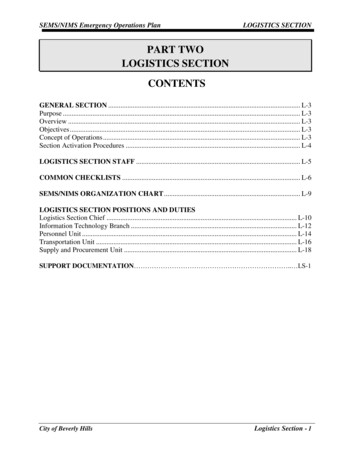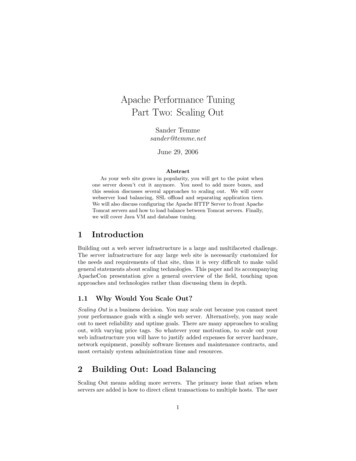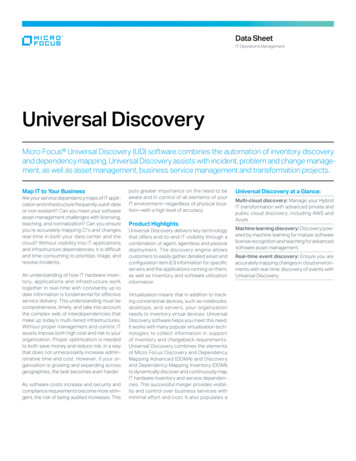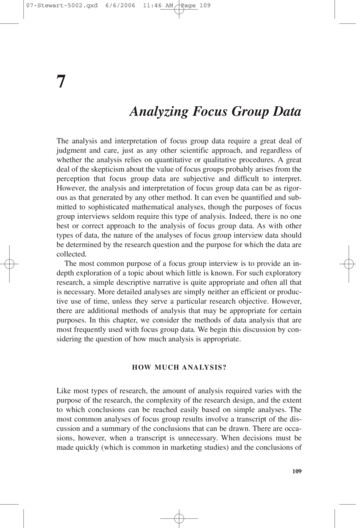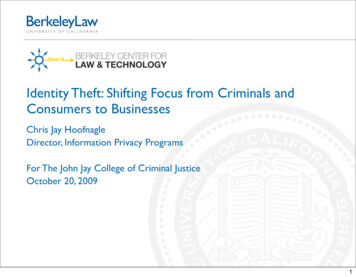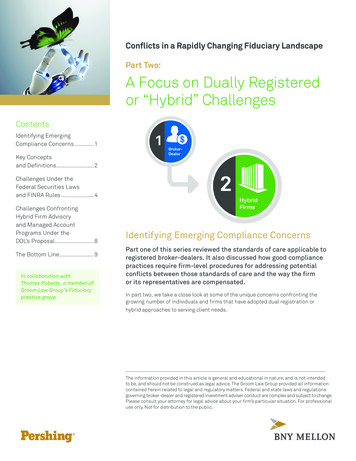
Transcription
Conflicts in a Rapidly Changing Fiduciary LandscapePart Two:A Focus on Dually Registeredor “Hybrid” ChallengesContentsIdentifying EmergingCompliance Concerns.1Key Conceptsand Definitions.2Challenges Under theFederal Securities Lawsand FINRA Rules.4Challenges ConfrontingHybrid Firm Advisoryand Managed AccountPrograms Under theDOL’s Proposal.8The Bottom Line.9In collaboration withThomas Roberts, a member ofGroom Law Group’s Fiduciarypractice group1BrokerDealer2HybridFirmsIdentifying Emerging Compliance ConcernsPart one of this series reviewed the standards of care applicable toregistered broker-dealers. It also discussed how good compliancepractices require firm-level procedures for addressing potentialconflicts between those standards of care and the way the firmor its representatives are compensated.In part two, we take a close look at some of the unique concerns confronting thegrowing number of individuals and firms that have adopted dual registration orhybrid approaches to serving client needs.The information provided in this article is general and educational in nature, and is not intendedto be, and should not be construed as legal advice. The Groom Law Group provided all informationcontained herein related to legal and regulatory matters. Federal and state laws and regulationsgoverning broker-dealer and registered investment adviser conduct are complex and subject to change.Please consult your attorney for legal advice about your firm’s particular situation. For professionaluse only. Not for distribution to the public.
Key Concepts and Definitions›› Where thedually registeredinvestmentprofessional isrepresenting adistinct brokerdealer and adistinct RIA,the client’sbrokerage andadvisory needs aremet by unrelatedorganizations.›› Where thedually registeredfinancialprofessional isrepresenting ahybrid firm, thesame organizationserves boththe client’sbrokerage andadvisory needs.Additionally, manyhybrid firms offerwrap accountprograms, whichmake activeinvestmentmanagementand brokerageavailable for asingle fee.2Within the industry, the terms “dually registered” and “hybrid” are often usedinterchangeably. They describe services offered at different organizational levels(i.e., at an individual representative level vs. a firm level). They also apply to differentorganizational structures (i.e., by single entity firms or by dual or multiple entityfirms that are commonly controlled). It is understandable then, that the terms aresometimes a source of confusion.For clarity, we will use the following terminology:›› “Dually Registered Advisor/Financial Professional” or “Hybrid Advisor” means anindividual (natural) person who is both a registered representative associated with abroker-dealer and an investment advisor representative of an RIA. This person mayeither be associated with a single, dually registered firm, with a broker-dealer and aregistered investment advisor that are affiliated, or with a distinct broker-dealer anda distinct RIA.›› “Dually Registered Firm” or “Hybrid Firm” refers to a registered broker-dealerfirm where the same legal entity or an affiliated legal entity is also a registeredinvestment advisor.›› “Distinct Broker-Dealer” means a registered broker-dealer firm that is neitherregistered as, nor affiliated with, an RIA, but that may permit its representativesto function as hybrid advisors.›› “Distinct RIA” refers to an RIA firm that is neither registered as, nor affiliated with,a broker-dealer, but that may be represented by hybrid advisors.Dual registration and hybrid models have become increasingly popular because theyhave a great deal of flexibility in serving client needs. A dually registered financialprofessional can serve clients by offering not only brokerage accounts, but also nondiscretionary advisory services, discretionary asset management services or some mixof all three.Hybrid firms and distinct broker-dealers that permit their registered representativesto function as hybrid advisors face unique challenges under the federal securitieslaws and FINRA rules. This is particularly complex since dually registered financialprofessionals and hybrid firms regularly encounter compensation-related conflictsof interest.
Key TermsDually Registered FinancialProfessional or Hybrid AdvisorDually Registered Firmor Hybrid FirmAn individual who is both aregistered representativeof a BD and an investmentadvisor representative ofan RIA.BD firm where the samelegal entity or an affiliatedlegal entity is also aregistered investmentadvisor.Distinct BDDistinct RIAA registered BD firm. Maypermit its representativesto serve as duallyregistered financialprofessionals.An RIA firm. May berepresented by duallyregistered financialprofessionals.Additional compliance challenges under the Employee Retirement Income Security Act of 1974(ERISA) and the Internal Revenue Code confront individuals and firms that provide investmentmanagement or non-discretionary advisory services to clients’ qualified plans or IRA assets.As discussed below, hybrid firms may have a financial interest in receiving and retainingfund-related revenue streams that may be available to them as a broker-dealer (i.e., 12b-1fees, service fees, and revenue sharing payments). These are based on investment managementdecisions or investment advice they or their affiliates provide as an RIA. These firms have afinancial conflict that the Department of Labor (DOL) is seeking to address in recent proposals.Importantly, the DOL’s proposals would curtail the availability of these revenue streams to hybridfirms. Hybrid firm management and compliance personnel will want to carefully monitor theDOL’s proposals and evaluate their potential impact on revenue streams available to the firm.On April 14, 2015, the DOL made available its long-awaited re-proposed regulationon the definition of “fiduciary” under section 3(21) of ERISA. The package of materialsproposed by the DOL included: A regulation re-defining who is a “fiduciary” by reason of providing investmentadvice to a plan or an IRA (the “2015 Proposed Regulation”); Two new prohibited transaction class exemptions; and Amendments to several existing prohibited transaction class exemptions.For additional information on the 2015 proposal, est.html.Part Two: A Focus on Dually Registered or “Hybrid” Challenges3
Challenges Under the Federal Securities Lawsand FINRA RulesAn Initial Hurdle: The Advisory Account Recommendations Versus Brokerage AccountRecommendations by Dually Registered Financial ProfessionalsFINRA, the self-regulatory organization for broker-dealers, requires member firmsto supervise the activities of hybrid advisors when they act as representatives of thebroker-dealer. FINRA also oversees when they act as representatives of the RIA, evenwhen the RIA is a distinct RIA. This supervisory responsibility manifests itself indifferent ways. First, the registered representative of the FINRA member firm mustobtain the broker-dealer’s consent to engage in the outside business activity ofrepresenting the RIA.1 The approval must be in writing. This is because therepresentation of the RIA would be expected to give rise to the registeredrepresentative’s receipt of compensation for outside activities involving securitiestransactions. Mere approval of the registered representatives serving as a duallyregistered representative is not enough. FINRA also requires that the broker-dealersupervise the suitability of recommendations made by a dually registered financialprofessional, including the suitability of a recommendation to establish an advisoryrelationship with a distinct RIA or a hybrid firm.In 2013, the SEC cited dually registered and hybrid approaches as a new and emergingrisk area that would be a focus of the Office of Compliance Inspection and Examination(OCIE).2 The SEC explained:Due to the continued convergence in the investment advisor and broker-dealerindustry, [OCIE] will continue to expand coordinated and joint examinations .of dually registered firms and distinct broker-dealer and investment advisorybusinesses that share common financial professionals.For example, it is not uncommon for a financial professional to conductbrokerage business through a registered broker-dealer that she does not ownor control and to conduct investment advisory business through a registeredinvestment advisor that she owns and controls, but that is not overseen by thebroker-dealer.This business model presents multiple conflicts. Among other things, the staffwill review how financial professionals and firms satisfy their suitabilityobligations when determining whether to recommend brokerage or advisoryaccounts, the financial incentives for making such recommendations, andwhether all conflicts of interest are fully and accurately disclosed. In addition,the staff will review dually registered firms’ policies and procedures tounderstand if such policies and procedures provide guidelines for when afinancial professional makes a securities recommendation to a customerwith a broker-dealer account versus an investment advisor account.41. NASD Rule 30402. See Office of Compliance Inspections and Examinations Examination Priorities for 2013, available xamination-program-priorities-2013.pdf
The SEC’s remarks indicate a concern that dually registered financial professionals,who can offer clients a choice between an advisory account and a brokerage accountor both, may have a financial conflict as to how to appropriately structure theclient relationship.As an example, a dually registered financial professional may recommend the pursuitof a client’s goals through an investment in A shares of a mutual fund held in a brokerageaccount. This recommendation would generate up-front sales commissions. Alternatively,an advisory account arrangement could be established for the same client that wouldinvest in no-load funds and under which the client would pay an ongoing, asset-based,advisory fee. A FINRA or SEC examiner may inquire about how the individual advisorarrived at his or her recommendation. Inquiries may be made as to whether the investor’sobjectives are best met through a buy and hold strategy, which would tend to suggest abrokerage account relationship, or through an advisory arrangement.1Demonstration thatthe recommendationof an advisoryaccount, as opposedto a brokerage-onlyarrangement, wassuitable and properlysupervised forsuitability.Recommendations that are driven by individual advisor compensation considerations,as opposed to meeting the client’s needs, will likely be met with regulatory concern.SEC and FINRA examiners are also likely to ask about whether the broker-dealer, withresponsibility for supervising the conduct of the dually registered financial professional,has policies and procedures in place for that individual to use in arriving at a brokerageonly vs. brokerage and an investment advisory account recommendation.Scrutiny may occur at multiple levels. First, with respect to the initial recommendationto the client regarding services, the firm will need to demonstrate that therecommendation of an advisory account was properly supervised for suitability.2Second, after an advisory relationship has been established and is ongoing, regulatorsmay inquire about whether the level of activity in the client’s account merits theadvisory fee it is paying. Advisory arrangements for small accounts or for investorswith a buy and hold orientation are likely to be questioned. In this respect, the firm willwant to demonstrate that it has monitored its client relationships to ensure that clientinterests are being served and that clients are receiving value-added services for theadvisor fees they are paying.Third, where a suitable advisory arrangement has been established, a hybrid firmshould be prepared to demonstrate that it has fully disclosed any conflicts of interestit may have in recommending investment products that generate revenue, such as12b-1 or revenue sharing payments for its broker-dealer.Scrutiny of Wrap Account Programs—“Reverse Churning”Regulators are also likely to inquire about the level of trading activity in client wrapfee arrangements. Wrap fee programs typically make available a combination ofinvestment management and brokerage services in exchange for a single “all in” annualfee (e.g., 1.5% of assets under management). Hybrid firms often offer proprietaryprograms under which client trades are placed by its broker-dealer, while investmentmanagement is provided by its RIA. Regulators have expressed concerns that theeconomics of these arrangements may cause hybrid firms to provide something lessthan the active investment management service that the client was promised. Becausetrading activity requires the firm to incur expenses, the profitability of a wrap feeaccount tends to increase if trading activity is minimized.3Demonstration thatthe firm has monitoredits client relationshipsto assure itself thatclient interests arebeing served and thatclients are receivingvalue added servicesin consideration of theadvisor fees they arepaying.Demonstration that thehybrid firm has fullydisclosed any conflictsof interest it may havein recommendingthrough its RIA theinvestment of clientaccounts in investmentproducts that generaterevenue, such as 12b-1or revenue sharingpayments for its BD.Part Two: A Focus on Dually Registered or “Hybrid” Challenges5
In 2014, OCIE sent an information request to a number of hybrid firms concerningwrap program arrangements. Among the 21 questions were requests for;The InvestmentAdvisers Act of1940 (Advisers Act)describes aninvestment advisoras: “anyone whoengages in thebusiness of advisingothers as to thevalue of securitiesor the advisabilityof investing in,purchasing or sellingsecurities forcompensation.”The SEC’s remarksindicate a concernthat duallyregistered financialprofessionals, whocan offer clients achoice between anadvisory accountand a brokerageaccount or both,may have a financialconflict as to howto appropriatelystructure the clientrelationship.››any analysis conducted by the firm to identify accounts with low levels of trading›› copies of trade blotters (i.e., purchases and sales journals) listing transactionsin securities and other financial instruments for current and former clients›› firm policies and procedures for monitoring wrap accounts with high cashbalances or low levels of trading›› the factors used by the firm to determine the suitability of wrap clients initiallyand on an on-going basis.For clients with little or no trading activity, a firm may be challenged to justifyits wrap fee and explain why the client, as a buy and hold investor, would not bebetter served through a traditional brokerage account arrangement.Identifying and Disclosing Conflicts of Interest to AdvisoryClients—the Conflicts Presented by Broker-Dealer RevenueSources and Best Execution ConcernsUnder the Advisers Act, a registered investment advisor is always obligated to servethe “best interest” of its clients and not to subordinate the interests of the client to itsown. In other words, a registered investment advisor is obligated to always put clientinterests first.Notwithstanding that general rule, for purposes of the federal securities laws,a registered investment advisor is permitted to render advice and makerecommendations to clients in instances where it may have a conflict of interest solong as that conflict has been fully disclosed to the client and the client has consentedto the advice relationship on a fully informed basis.3 The legal basis for the exception isthe notion where an advisor has made “full and frank disclosure” of its conflict ofinterest. The advisor’s client then is positioned to evaluate the investment advisor’sconflicting interests and to make an informed decision about whether the advisor canserve the client’s interests in light of the advisor’s own financial interests.Advisory account relationships established by hybrid firms typically also involve abrokerage account with the same firm. In such instances, the sources of revenueavailable to the broker-dealer in connection with the account’s holdings often give riseto a conflict of interest. With respect to mutual fund investments, for example, anyrevenue sharing arrangements that the broker-dealer may have with particular fundscould provide a financial incentive to the firm’s advisory arm to recommend fundsbased on those revenue considerations. Under such circumstances, it is important thatthe investment advisor identify the conflict to its clients and take steps to assure thatthe client has consented to the advice arrangement with full knowledge of the conflict.A related issue involves the investment advisor’s duty to clients to obtain the bestexecution of their transactions.4 The term “best execution” is not itself defined underthe Advisers Act, but has come to be defined over time through SEC enforcementactions alleging failure to achieve best execution. In essence, best execution is a duty tosee that client trades are executed in a manner in which the client’s costs and proceedsin each transaction are the most favorable available given the circumstances.3.6I t is important to remember that disclosure of conflicts in the manner required by federal securities laws,by itself, is insufficient to avoid the prohibited transaction restrictions of ERISA and the Code that may applyto qualified plan and IRA client recommendations.
Typically, a best execution analysis requires consideration of both qualitativeand quantitative factors. Quantitative analysis involves consideration of price andcommission rates, while qualitative analysis involves factors such as the broker’sability to handle trades, financial stability, reputation and overall knowledge of themarket. In 2013, the SEC brought a best execution enforcement action against ahybrid firm alleging a discrepancy between the firm’s statements concerning itsbest execution policies and procedures and its actual practice.5 The firm’s Form ADVindicated that it would consider a list of factors and would conduct a comparativebrokerage firm commission rate analysis. The SEC alleged that the firm alwaysdirected advisory client trades through itself as broker-dealer without consideringother options for executing the trades, such as unaffiliated broker-dealers. Further,the SEC alleged that the firm misrepresented to clients that use of the firm’s brokerdealer capabilities for trade execution would result in lower commission costs whenin fact that was not necessarily the case. The firm agreed to pay a 500,000 fine aspart of the resolution of the case.Best execution isa duty to see thatclient trades areexecuted in amanner in which theclient’s costs andproceeds in eachtransaction are themost favorableavailable given thecircumstances.The SEC also brought a best execution enforcement action against another hybrid firmthat resulted in more than 1 million in fines and penalties.6 The firm served as brokerdealer for advisory client accounts and charged a stated commission rate per tradedshare, which was shared with the firm’s clearing broker on an 80% to 20% basis. Thefirm later re-negotiated the basis on which commissions were split with its clearingfirm to a 90%/10% basis, but was alleged to have failed to notify its clients of thatchange or to have undertaken a best execution review in light of the change. Basedon these actions, a hybrid firm may want to consider conducting periodic reviews toevaluate whether its RIA business is obtaining best execution for clients through itsbroker-dealer, confirming the firm’s adherence to its best execution policies andprocedures, as disclosed to clients.Many hybrid firms are already aware of questions securities regulators have raisedconcerning
Key Concepts and Definitions Within the industry, the terms “dually registered” and “hybrid” are often used interchangeably. They describe services offered at different organizational levels . a broker-dealer



